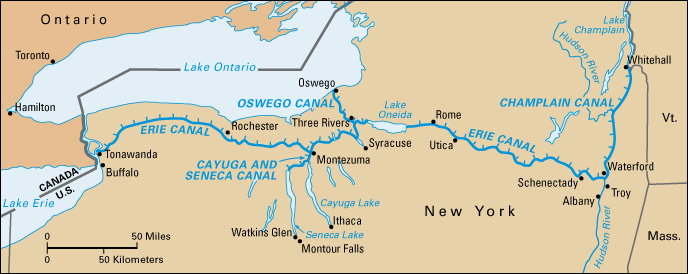New York State Canal System connects the state’s principal natural waterways. It was formally opened in 1918 as the New York State Barge Canal system. The system updated and integrated four canals built between 1813 and 1828. The 524-mile (843-kilometer) system links two of the Great Lakes (Erie and Ontario), two of the Finger Lakes (Cayuga and Seneca), Lake Champlain, and navigable portions of the Mohawk and Hudson rivers. The Hudson River connects the system to New York City.

The New York State Legislature authorized construction of the canal system in 1903. It did so under strong pressure from business people anxious to create an enhanced alternative to the railroads. The project widened, deepened, and sometimes rerouted existing canals. The canal system has 57 locks, each 300 feet (91 meters) long and 43 1/2 feet (13.3 meters) wide. It has a minimum overall channel depth of 12 feet (3.7 meters).
The system consists of four canals—the Erie, the Champlain, the Oswego, and the Cayuga and Seneca. The 348-mile (560-kilometer) Erie Canal connects Tonawanda on the Niagara River with Waterford on the Hudson River (see Erie Canal ). The 60-mile (97-kilometer) Champlain Canal links Waterford with Whitehall on Lake Champlain. The 24-mile (39-kilometer) Oswego Canal links Oswego on Lake Ontario and Three Rivers on the Erie Canal. The 92-mile (148-kilometer) Cayuga and Seneca Canal extends from the Erie Canal at Montezuma to reach Ithaca at the southern end of Cayuga Lake and Watkins Glen at the southern end of Seneca Lake.
Since the 1950’s, the use of the system for shipping cargo has declined considerably. At the same time, its use for pleasure boating has increased. In 1992, the State Legislature transferred responsibility for the system from the Department of Transportation to the New York State Thruway Authority. It also took the word Barge out of the system’s name to emphasize the recreational potential of the canals.
